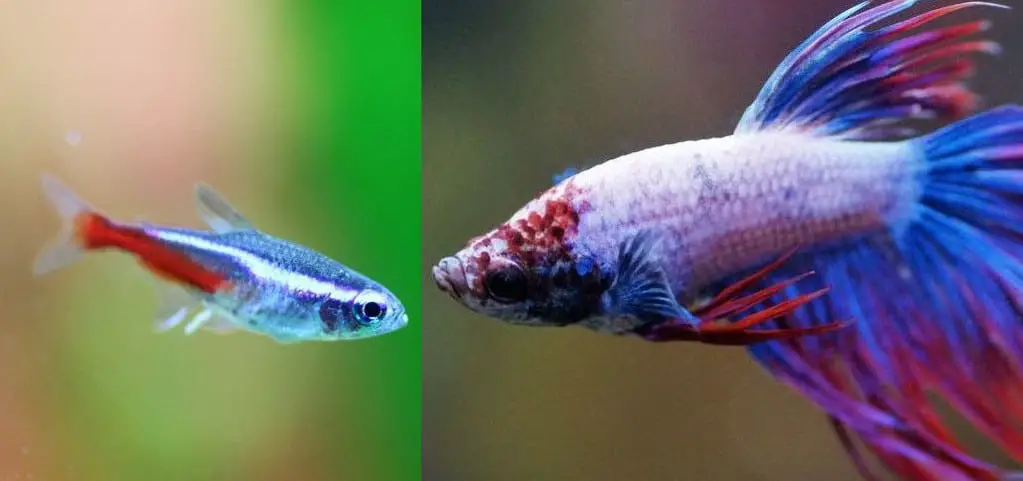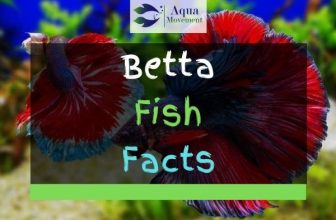Betta Fish and Neon Tetras in same Tank?
Ideally, aquariums should be full of variety and color. This usually requires adding a healthy mixture of different fish species, aquatic plants, and maybe even some ornaments or coral. These can all contribute to a glowing ecosystem and a very aesthetically pleasing feature for you, the observer.
However, what do you do when one of your tank’s inhabitants is slightly troublesome or aggressive?
Well, this is the circumstances that any owners of Betta find themselves in.
These spectacular ‘fighting fish’ are much sought after in the aquarium community, but their aggression and distinctly territorial nature can make it difficult to find a suitable tank mate.
The ideal tank mate for a betta is one that is unlikely to provoke them, unlikely to become prey, and thrives in the same water conditions. Unfortunately, this limits your choice quite a lot.
If you choose the wrong species to share your tank with a betta, the results could be disastrous, for one or both parties. Firstly, there may be a direct predator prey dynamic established, and in the confines of a tank the prey doesn’t have much of a chance.
Alternatively, there may be some underlying aggression or bullying which could cause great distress for your fish, or else there could be a competition for resources which is also likely to lead to a decline in health.
All this can be avoided by carefully choosing the right partner fish for your betta.
Table of Contents
Betta Fish
Video: “Don’t Buy A Betta Fish Without Watching This First. 10 Things You Should Know About Betta Fish.”
You may know betta fish by their alternate name, the Siamese fighting fish. This gives a good insight into their attitude and really helps clarify what problems they could cause in a community tank.
The betta is native to the shallow freshwater paddy fields of the countries of Indochina, including flat lands in Vietnam, Cambodia, Thailand and Laos.
In the wild they do display some natural aggression, but this is more tempered, and usually fish will not fight to the death and instead engagements are swift and quickly forgotten.
This is certainly not the case with their domesticated cousins.
Through generations of selective breeding the aggression of the betta has been greatly enhanced. This has happened ever since they were first isolated for aquarium use and imported to Europe at the end of the nineteenth century.
In fact, their fighting instincts are so famous that a form of gambling has grown up in some places surrounding fish fighting, though this is banned in most countries. Mature adults can grow up to 2.8 inches in length.
Another thing that differs between these fish in the wild and in an aquarium is their color. In their native waters they are generally dull colored, such as brown, grey or greens.
However, in aquariums their colors are greatly enhanced and they can display very vivid greens, orange and red colors. They also have a wide variety of spectacular fin variations. All of these features have made it one of the most popular aquarium fish in the world, though it is not recommended for beginners.
Neon Tetra
Video: “Neon Tetra Care, Information and advice”
You might wonder, what would be an appropriate tank mate for such a fearsome creature as this.
Well, one option is the small Neon Tetra. This is a freshwater fish from the family characin, and it is commonly used in community freshwater tanks. It is native to the shallows and small streams of the Amazon river basin in South America, but it has grown to be a very popular addition to aquariums all over the world.
This is a very beautiful, iridescent fish which is characterized by horizontal blue and red stripes on its body, extending from its mouth to its back fin. It is partially transparent and it can grow to be about 1.2 inches in size.
This size means it is not a natural prey for the Siamese fighting fish, although it could be bullied or attacked if it swims alone.
In terms of their behavior they are very timid creatures who are not going to threaten the supremacy of the betta in the tank. This is safer for them and better for your tank.
In fact, they are largely peaceable creatures and the two species may just ignore each other in the tank.
Can betta and neon tetra live in the same tank?
You might be suspicious about how a fierce, territorial fish like the betta, and a timid, shoaling fish like the neon tetra can live in the same tank, but experience has shown that often they can survive and even thrive together in close quarters.
In a tank, the neon tetra like to keep to the middle of the tank, and they are generally very careful to keep well away from the larger betta, and will do anything to not provoke their anger. It is important to remember that in the wild tetras like to live in shoals, and you should try and recreate this in your tank.
Neon tetra will feel much more secure and safe when they are surrounded by members of the same species. Not only will this make the betta less likely to attack them, but it also gives them the confidence to display their colors more strongly. This is a wonderful side benefit for you, as a tank owner!
It is usually advised to have a minimum of 6 neon tetra in the tank, as single fish can become easy prey. If you can, and you have the space to allow it, you should consider having even more neon tetra.
It is important to understand what your betta is capable of. If you have a very aggressive betta who strikes out often, then no smaller fish or shrimp is likely to be safe in the same tank.
However, if you know that your betta is relatively calm and gentle, then you can have more peace of mind when introducing new fish.
Do betta and neon tetra like the same conditions?
One very important consideration when deciding whether species are compatible is whether or not they tolerate the same water conditions. This means are they happy to survive in water of the same temperature, pH, salinity, hardness etc.
Fortunately for tank owners, betta and neon tetra have very similar requirements.
Firstly, both betta and neon tetra come from hot climates so they are used to similar water temperatures. For neon tetra, the optimum temperature range is from 21 to 27 C, while for the betta fish prefer slightly warmer temperatures of 24-28 C.
Thus a temperature of 24-27 C should satisfy both tank occupants.
You need to make sure that this is also suitable for any other tank inhabitants, including any shrimp, or aquatic plants.
They also have similar requirements with respect to pH and other aspects of water chemistry. pH refers to the acidity of the water, with acidic water scoring lowering than alkaline water in the pH scale, which goes from 0 to 14.
Betta fish like neutral conditions, (pH 7), but neon tetra would prefer slightly acidic waters (pH 6-6.5), since that is what they are used to in the wild. Betta are more tolerant of changes in acidity than neon tetra, who may react violently to even small variations in pH.
In terms of water hardness and salinity, both species are compatible. Both species like softer water (i.e. water with a low concentration of dissolved minerals), and both are freshwater fish who are very intolerant of saline conditions.
This means it is important to keep levels of dissolved salt under control, as well as making sure that there is adequate filtration in the tank, to keep the waters clean and clear.
Tips for a happy life

Regardless of how compatible two species are in terms of their preferred water conditions, there are some very important guidelines for you to follow to ensure they can coexist peaceable in your tank.
If you don’t follow these precautionary tales, you may find a nightmarish scene one day in your tank!
Firstly, the most important trick to keeping the peace in your tank is adequate feeding. You need to make sure that your fish have a fulfilling diet which meets all their requirements for protein, energy, vitamins and minerals. If you don’t feed them sufficiently, (two or three times a day), then your fish may look to supplement their needs themselves.
This is especially true if there is a competition for resources in your tank, as the betta may turn aggressive and lash out at your tetra.
As well as feeding the larger betta, make sure your tetras get a good feeding. They are omnivores and will happily eat most flake or pellet foods They will often eat the scraps left behind by the betta, but you should keep an eye out to ensure they are getting their daily intake.
The other crucial consideration is space. Although fighting fish are accustomed to congested waters, there is a minimum size of tank they will tolerate. You should keep them in a tank whose volume is at least 10 gallons.
If you are adding a large school of tetra, you should increase this. In general, a larger tank will reduce acts of aggression and allow each species to keep peaceably to themselves.
General Requirements
We have shown that betta and neon tetra fish can make suitable tank mates in the right circumstances. But there are some general requirements when selecting any fish to share a tank with a betta, which you should keep in mind.
Firstly, you should not add fish that are known as ‘nibblers’. These fish tend to peck at the fins and bodies of other fish, and if they provoke a species such as the Betta, they will not last long!
Also, ideally fish should be small, and not intimidating. This means they should not display strutting, confident behavior or bright coloring. If they do then the betta might feel threatened and may strike out to assert their dominance. This is one of the major reasons why betta and neon tetra often work so well together.
Bottom fish (i.e. fish such as catfish and loaches that keep to the floor of the aquarium) are equally unlikely to threaten a betta, and may also make good tank companions.
Even with the most suitable of tanks, your smaller fish may sometimes feel intimidated, so it is important to add rocks, plants and other ornaments where the smaller fish can take refuge in times of danger.
This will help to lower their stress levels and preserve harmony in your tank.
Alternatives
Some other options if you don’t want to introduce neon tetra are the bristlenose pleco, cory catfish, glass catfish or the kuhli loach. All these fish are somewhat reclusive and shy, and will tend to stay out of the way of the betta.
However, some may grow to quite a large size, at which point the betta might see them as a threat and decide to lash out. You should replace them with smaller fish before this occurs.
Conclusion
It can be a difficult task to find a tank mate for a species like the Siamese fighting fish aka. the betta. It is famously territorial and will not like to be threatened in its own tank. As a result, even when you bring in small, affable species like the neon tetra you need to manage the introduction carefully and gradually.
There are a number of reasons why the betta and neon tetra are suitable tank mates. Most significantly, the smaller, timid neon tetra is not likely to threaten or rile up the betta. Also, they have very compatible water requirements in terms or temperature, pH and other things.
So long as you make sure that your fish are kept adequately fed, you introduce the neon tetra in larger groups, and you provide enough space for both species to keep apart, then you should have no real issues with this combination.
This is a great way for you to enjoy the sight of the fearsome fighting fish in a stimulating, dynamic community environment.




